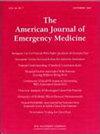Abdominal pain in the emergency department: 50 years on
IF 2.7
3区 医学
Q1 EMERGENCY MEDICINE
引用次数: 0
Abstract
Objective
Emergency Department (ED) patients with abdominal pain continue to represent a diagnostic challenge. This study of demographics, evaluation, and outcomes provides a look at stability and change over a 50-year span at a single institution.
Methods
The current study is the fourth version of this exercise, marking the 50th anniversary of the first examination. The charts of 1000 adult patients presenting to a tertiary care ED in 2022 with a chief complaint of abdominal pain were reviewed. Data extracted included demographics, diagnosis, disposition, and use of imaging and laboratory testing. Where possible, comparison between this study and the previous studies was performed.
Results
The results demonstrated considerably increased use of computed tomography (CT) (+69 %) and ultrasound (+32 %) and a reduction in abdominal radiographs (−68 %) over the past 15 years. Prolonged evaluation time, length of stay, and higher charges accompanied this pattern of increased imaging. Notable findings included continued low frequency of missed surgical illness relative to 1972, but minimal change in the number of patients (~29 %) hospitalized.
Conclusions
Over a 50-year span, ED evaluation of abdominal pain has become more effective at diagnosing acute surgical illness, but less efficient and more costly. The percentage of patients hospitalized has been remarkably stable.
求助全文
约1分钟内获得全文
求助全文
来源期刊
CiteScore
6.00
自引率
5.60%
发文量
730
审稿时长
42 days
期刊介绍:
A distinctive blend of practicality and scholarliness makes the American Journal of Emergency Medicine a key source for information on emergency medical care. Covering all activities concerned with emergency medicine, it is the journal to turn to for information to help increase the ability to understand, recognize and treat emergency conditions. Issues contain clinical articles, case reports, review articles, editorials, international notes, book reviews and more.

 求助内容:
求助内容: 应助结果提醒方式:
应助结果提醒方式:


